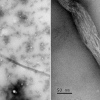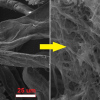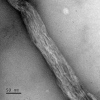A method of production of nanofibrillated cellulose
Technology description
| The name of the technology: | A method of production of nanofibrillated cellulose |
|---|---|
| Challenge: |
The separation and isolation of the single nanofibres from regular macrocellulose is a non-trivial task, due to the strong forces standing between each fibre which keep them stacked against one another. Depending on the method of nanocellulose production, the types of nanocellulose can be cellulose nanofibers (CNFs) or cellulose nanocrystals (CNCs). Among all, the mechanical route is any type of nanocellulose processing and synthesis that is based on the resorting of mechanical techniques. The set of techniques are convenient for being simple and scalable making them suitable forlarge-scale production, and versatile as they are capable of producing both CNCs and CNFs depending on the specific mechanical treatment. However, the main drawback is energy consumption: some mechanical methods may require significant energyinput, especially high-pressure homogenization. |
| Description: |
The aim of our invention is to provide an inexpensive and eco-friendly method of production of nanofibrillated cellulose. Said method solve shortcomings of current techniques, including cost of production, energy consumption, eco-sustainability, efficiency and scaling up of the process, very important for industrial production. The method makes use of a semisolid aqueous-based medium composed of sodium silicate in which the cellulose precursors are dispersed, and machines capable of imparting a powerful high-speed deformation, to massively breaks the cellulose chains and chop the fibers down to nanometric size. Moreover, the method also provides an efficient, low-cost and eco-friendly solution for the long-term storage of nanofibrillated cellulose. Main advantages: • Low-cost: As the synthesis of the fully recyclable waterglass is made up of inexpensive input materials. • Easy to reproduce: Requires no sophisticated, expensive machines. • Eco-firendly, non-toxic: Use an aqueous medium. • Effective and efficient: To produce nanofibrillated cellulose and it does not require long time of processing and or pre-treatments. • High quality and purity: Of the produced nanofibrillated cellulose, as the aqueous medium is easily washable. • Scalable: Suitable for mass-production. • Versatile and flexible: Waterglass medium can be used for storage or further synthesis of nanocomposite. • Storage medium: The medium is also a storage medium for the preservation of defibrillated nanocellulos. • Less energy consumption: The same quality of the final product under atmosphere pressure. • Recyclable: Used water or the sodium silicate can be further recycled for new batches, limiting the consumption of raw materials and no toxic gases are generated during these reactions. |
| Commercial opportunity: |
• Application 1: Technology development into industrial scale production of nanomaterials (CNFs; MFC, blends). • Application 2: Development of specific industrial applications of the nanomaterials (Paper and packaging industry; Composite materials; Textile industry; Cosmetics and personal care; Electronics and energy; Medical and pharmaceutical; Food industry; Water, air filtration). |
| IP protection status: | International patent application: PCT/SK2024/050005 - Method of production of nanofibrillated cellulose. |
| Development status: |
Phase 2Corresponds with TRL 3 and TRL 4 Feasibility study. There is a realistic design of the technology and the initial tests in the laboratory are leading to the specification of the technology requirements and its capabilities.
|
| Partnering strategy: | Collaboration licensing |
| More information: |
Ing. Luca Bertolla, Ph.D., of IPM CAS, and Ing. Gianmarco Taveri, Ph.D., of CEMEA SAS, are collaborating on the advancement of this technology. Image description: SEM images showing the morphology and size of raw cellulose fibres (left) and after the silicate treatment (right). EDS spectrum (insert in the right) proves the purity of the produced CNFs, as no other elements than carbon and oxygen were detected. |
| Images: | |
| Categories: | Nanotechnology |
| Institution: | Institute of Physics of Materials CAS |
| Owner of a technology: | Ústav fyziky materiálů AV ČR, v. v. i.; Centrum pre využitie pokročilých materiálov SAV, v. v. i. (CEMEA) |


